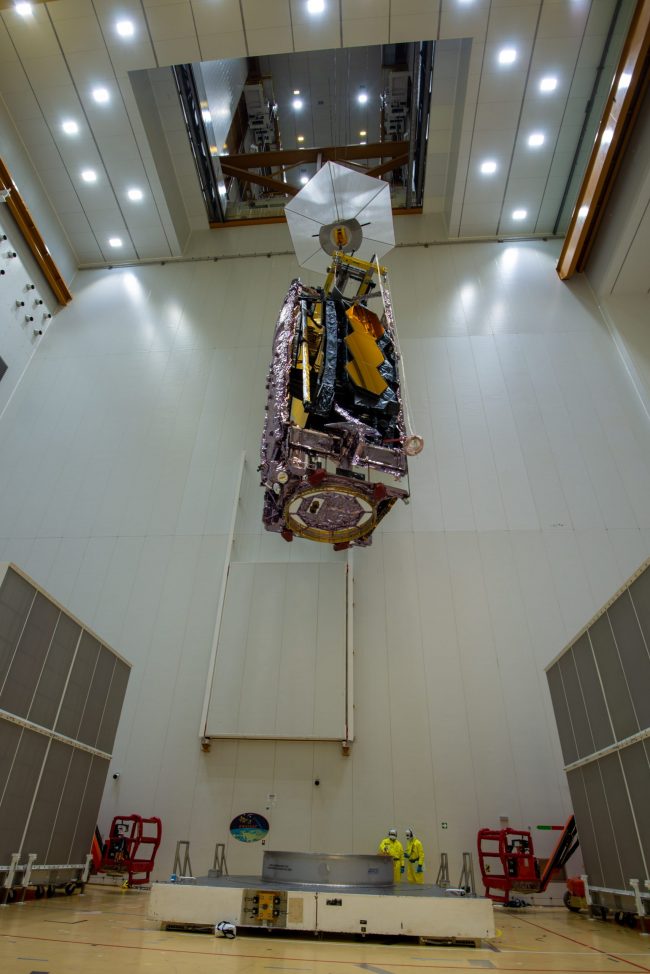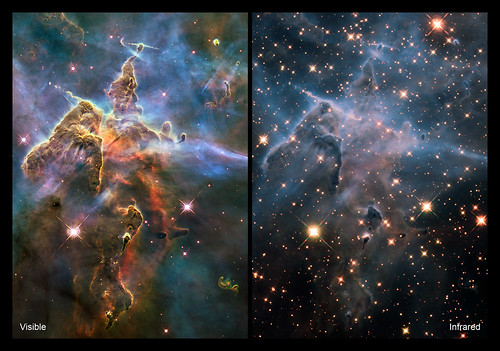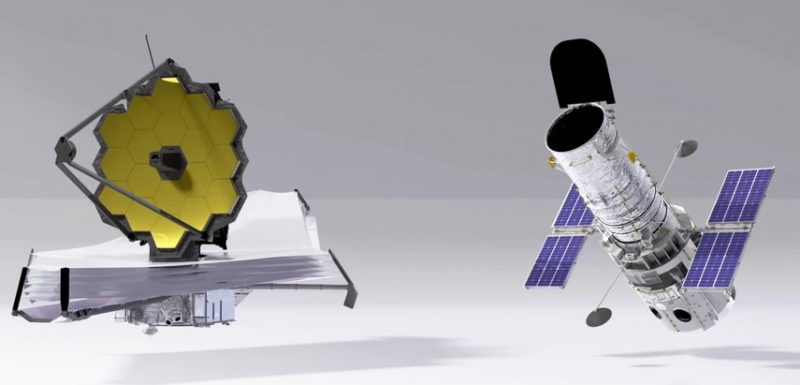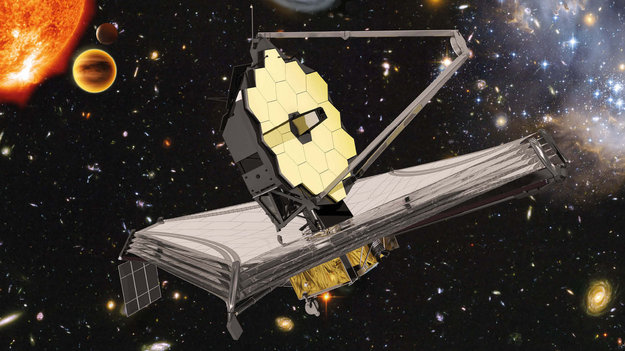UPDATE DECEMBER 25, 2021: The James Webb Space Telescope launched successfully via an Ariane 5 rocket this morning at 7:20 EST (12:20 UTC). At this writing, broadcasts of the launch are continuing on NASA Television and the agency’s website, as well as YouTube, Twitter, Facebook, LinkedIn, Twitch, Theta.TV and NASA’s App.
Read: James Webb Space Telescope’s final destination
Here is that moment, preserved for posterity! #UnfoldTheUniverse #NASAWebb pic.twitter.com/p5KpZGVB1C
— NASA Webb Telescope (@NASAWebb) December 25, 2021
Hubble’s successor
The Webb Telescope is the long-awaited successor to the Hubble Space Telescope. The $9.7-billion space telescope has been under development for decades. It has undergone many delays over its long history.
The Webb will go up on an Ariane 5 rocket, a tried-and-true vehicle with a streak of 82 consecutive successful launches between April 2003 and December 2017. The Ariane 5 is part of the European Space Agency’s contribution to the mission. The launch will take place at Europe’s spaceport located in French Guiana. Then, according to many observers, the real nail-biting will begin as the telescope begins a month-long unfolding process, all the while traveling farther, and farther, from Earth.
In summer 2021, NASA had announced that the telescope would ship to the launch site in August “with little to no schedule margin.” That tight schedule would bring the telescope to launch readiness no earlier than October 31. A new launch date of December 18, 2021, was announced in September. But delays kept occurring.
Following launch, the telescope will require about a month to travel to L2, the second Lagrangian point, a point located at some four times the moon’s distance.
For more about the deployment sequence, see the video below.
Read more about the launch site
The 2022 lunar calendars are here. Order yours before they’re gone!


Launch from near Earth’s equator
Following launch, Webb will take about a month to fly to the L2 point in space. As it travels there, beginning a few days after launch, it’ll start to slowly unfold its biggest feature, its tennis court-sized sunshield. The sunshield is designed to reduce the sun’s heat by more than a million times to -364 degrees F (-220 degrees C). Webb’s mirror and instrumentation have to be kept cold. If they were to be heated up by the sun, they’d give off infrared radiation. And it’s faint infrared signals from the distant cosmos that the Webb is meant to measure. ESA commented that each step of the cool-down process:
… can be controlled expertly from the ground, giving Webb’s launch full control to circumnavigate any unforeseen issues with deployment.
ESA said the mission team can manage the cool-down, which will take several weeks, with heaters to control stresses on instruments and structures. In the meantime, ESA said:
… the secondary mirror tripod will unfold, the primary mirror will unfold, Webb’s instruments will slowly power up, and thruster firings will insert the observatory into a prescribed orbit.
After orbital insertion, and after the telescope has cooled down and stabilized at its frigid operating temperature, the mission team will spend several months aligning its optics and calibrating its scientific instruments. Then Webb will begin studying the cosmos in infrared light using its dazzling golden mirror.

What’s huge, grand, and golden?
One of the Webb’s most important and identifiable attributes is its 21-foot-wide (6.5-meter-wide) primary mirror. A reflecting telescope’s primary mirror determines how much light it can collect, and thus how deeply it can see into the universe. Webb’s mirror is nearly three times wider than Hubble’s primary mirror.
You might hear people speak of the Webb’s golden mirror. The mirror is actually multiple mirrors. It’s composed of 18 separate hexagonal-shaped segments made of very strong, ultra-lightweight beryllium, which will unfold after launch. Each of the telescope’s mirror segments is covered in a microscopically thin layer of gold. This gold covering optimizes the mirror segments for reflecting infrared light, which is the primary wavelength of light this telescope will observe.
Webb Telescope has had a long road
The Space Telescope Science Institute website explained:
.Work on the project began over 30 years ago at STScI with a challenge from Institute Director Riccardo Giacconi to ‘think about the next major mission beyond Hubble’ …
The Webb’s development began in earnest in 1996, with a $500 million budget. Space scientists and engineers initially planned the launch for 2007. But the project has had considerable delays and cost overruns, and it underwent a major redesign in 2005. Afterward, they planned the launch for March 2020, but the coronavirus pandemic struck and caused major setbacks.
In December 2020, the sunshield of a fully assembled James Webb Space Telescope successfully completed its own final tests, including a complete unfolding, as the telescope will need to do once in space.
Formerly known as the Next Generation Space Telescope, scientists renamed the Webb in September 2002 after James Webb, who was an esteemed former NASA administrator.
NASA, the European Space Agency, and the Canadian Space Agency are partnering on the Webb. NASA’s Goddard Space Flight Center in Greenbelt, Maryland, manages the development effort, while Northrop Grumman serves as the project’s main industrial partner.
As it has for the Hubble Space Telescope, the Space Telescope Science Institute in Baltimore will be operating the Webb telescope after launch.
For more about the history of the Webb, read NGST: The Early Days of the James Webb Space Telescope (JWST)

Technologies advance
As you would expect, the capabilities of the Webb extend beyond those of the Hubble Space Telescope. NASA likes to say that the Webb is not a replacement for Hubble, but rather a successor. The two telescopes will collaborate side by side for a while, with a planned overlap.
The Webb will observe farther into the infrared regions of the electromagnetic spectrum than Hubble. It’ll go even deeper into space than Hubble, and thus it’ll look farther into the past. It’ll be able to peer inside stellar dust clouds where stars and star systems form. Thaddeus Cesari, a communications specialist for the mission, wrote:
In addition to the groundbreaking science expected from it after launch, Webb has required an improvement in the testing infrastructure and processes involved in validating large complex spacecraft for a life in space … Lessons learned from previous space telescope development were invested into Webb, and future space telescopes will be built upon the same collective knowledge.
Thousands of scientists, engineers, and technicians contributed to build, test, and integrate Webb. In total, 258 companies, agencies, and universities participated: 142 from the United States, 104 from 12 European nations, and 12 from Canada.



Bottom line: NASA has confirmed that the James Webb Space Telescope will launch on December 25, 2021.
Source: NASA











